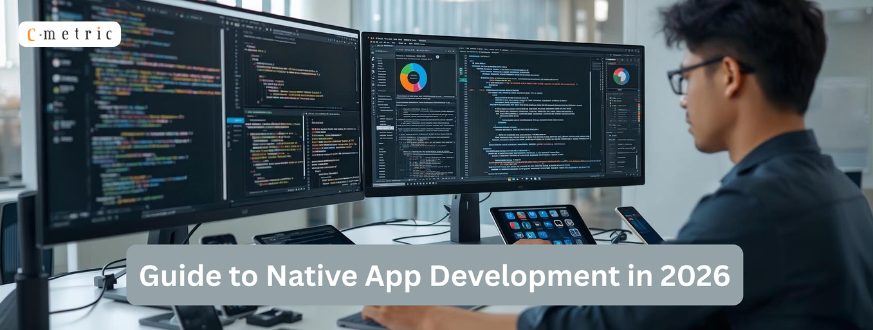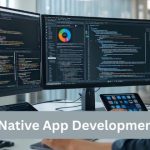Creating mobile apps has been the backbone of many popular platforms like Instagram and WhatsApp. If you want to build an app that runs fast and performs well, native app development brings benefits that other methods just can’t offer.
Native app development has the advantage of providing faster performance, solid security, and better integration with a device’s hardware. The idea of building a native app might feel overwhelming, but it is important to understand the costs involved in planning. In 2026, the cost to build a native app will start at $15,000 for basic apps and can exceed $150,000 for more advanced, complex applications.
This guide will cover all you need to know to develop native apps in 2026. You’ll learn about the steps involved, the costs of building for iOS and Android, and whether this method aligns with your business goals.
What is Native App Development and Its Benefits
Native app development means building software meant to work on specific operating systems using languages unique to those platforms. Developers use Java or Kotlin for making Android apps, while Swift or Objective-C is used to create iOS apps. These languages help apps make full use of device features and fit within the platform’s system.
Native development focuses on using tools designed for specific platforms. iOS programmers rely on Xcode as their main development environment and tap into Apple’s SDKs. On the other hand, Android programmers use Android Studio alongside Google’s tools. This focus on specific tools offers direct interaction with device features like cameras, GPS, and fingerprint sensors.
Building native apps comes with many benefits. They are compiled straight into machine code, which allows them to work with the operating system. This removes the need for extra layers that might slow things down. Plus, they stick to the design rules of their platforms giving users an interface that feels familiar and easy to navigate.
One major advantage of native development is strong security. Unlike hybrid apps that depend on browser-based protection native apps benefit from several layers of protection built into the operating system. They also support advanced security methods such as encrypting files, storing keys, and using biometric logins.
However, developers face the challenge of managing separate codebases to create apps for both iOS and Android. This task can take more time and lead to higher costs.
How Native Apps Are Built in 2026
Creating effective native apps in 2026 involves a more polished method that begins by validating ideas. Instead of guessing skilled developers now use AI tools to check market interest and compare features with competitors’ offerings. This essential step ensures that resources are not wasted on ideas that lack real demand.
After validation, the process of creating an app moves through clear stages. iOS developers rely on tools like Swift and SwiftUI. On the other hand, Android developers mainly work with Kotlin and Jetpack Compose. Industry reports show apps built with Kotlin crash 20% less often than other options.
Designing the user interface and experience involves unique platform rules. iOS sticks to Apple’s Human Interface Guidelines. Android however, uses Material Design principles. These systems help the apps feel natural to users on their respective platforms.
Testing is a key part of building apps. By 2026, combining automated tools with manual checks is common to confirm apps work run well, and stay secure. Using cloud testing tools allows access to real devices. This step is crucial to test how apps behave on different screens and operating systems.
Preparing for deployment includes getting the app ready to submit to the app store. Beginning in April 2026, developers need to ensure that apps uploaded to App Store Connect are built using the iOS and iPadOS 26 SDK or newer. This shows how crucial it is to keep up with platform updates.
Cost and Technology Stack to Build Native Apps in 2026
Choosing the best mobile app tech stack has a big effect on how your app grows and runs, from how it’s built to how well it performs when it faces high demand. The price of building native apps can change a lot depending on how advanced they are.
- Simple apps with straightforward tools cost around $15,000 to $50,000 and take about 2 to 3 months to finish.
- Apps with medium-level complexity that include things like payment systems or unique designs often cost between $50,000 and $120,000, with completion times ranging from 3 to 9 months.
- Complex apps with more advanced features can cost anywhere from $100,000 to $300,000 and might take at least 10 months or even longer to complete.
- To create iOS apps, developers use Swift because it prioritizes safety and works. Most programmers rely on Xcode, the official macOS-specific IDE from Apple. As a result, building iOS apps costs between $25,000 and $250,000.
- When it comes to Android apps, Kotlin is now the go-to language supported by Google. Developers use Android Studio as the main platform, which comes with tools like Android Virtual Device to test applications. The costs to develop Android apps fall between $20,000 and $250,000.
Keeping up with maintenance each year costs around 15-20% of what was spent on development at first. It includes things like handling bugs making updates, and adapting to platform changes. Choosing the right tech stack is essential to match your app’s purpose, your team’s skills, and how well it can grow in the future.
Native App Development in 2026: A Smart Choice
Native mobile app development services offer superior performance, strong security, and seamless hardware integration, making them a top choice for mobile development in 2026. While native development requires separate code for iOS (Swift) and Android (Kotlin), it provides clear advantages for businesses seeking speed and reliability.
AI tools now help developers make data-driven decisions, optimizing both time and cost. However, native app development can be expensive, ranging from $15,000 to over $300,000, depending on the complexity. The investment pays off with better user experience, performance, and security.
Maintenance costs are typically 15-20% of the initial development cost. If high performance and tight integration with device hardware are critical, native development is worth the investment.













Get in Touch